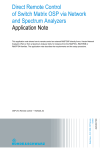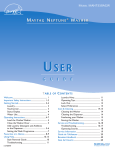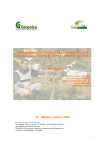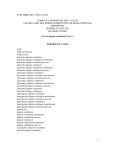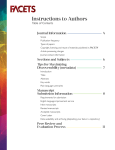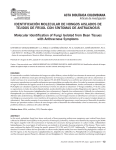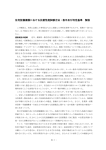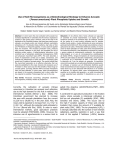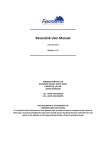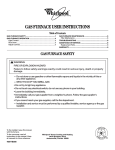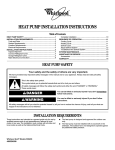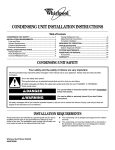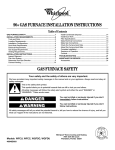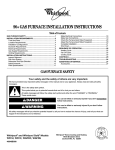Download Plant Germplasm Centers and Microbial Culture
Transcript
Carolyn Babcock Canadian Collection of Fungal Cultures, Agriculture and Agri-Food Canada, Ottawa, Ontario K1A OC6 Frank M. Dugan USDA-ARS Western Regional Plant Introduction Station, Pullman, WA 99164 Xianming Chen USDA-ARS Wheat Genetics, Quality, Physiology, and Disease Research Unit, Pullman, WA 99164 Blair Goates USDA-ARS National Small Grains Germplasm Research Facility, Aberdeen, ID 83210 Pedro W. Crous Centraalbureau voor Schimmelcultures, P.O. Box 85167, 3508 AD Utrecht, the Netherlands Peter N. Green NCIMB Ltd., Ferguson Building, Craibstone Estate, Bucksburn, Aberdeen AB21 9YA Scotland Plant Germplasm Centers and Microbial Culture Collections A User’s Guide to Key Genetic Resources for Plant Pathology Collections containing microbes (often referred to as “culture collections”) and collections of seeds or clonal materials for higher plants (often referred to as “germplasm collections”) can provide abundant resources for plant pathologists, breeders, geneticists, and other plant science professionals. However, many such professionals (including graduate students, postdoctoral fellows, and technical staff) lack adequate guidance on locating, obtaining, and processing such materials. Regulatory procedures and considerations of biological security, ambiguities regarding intellectual property rights, lack of knowledge about collection databases, and other hurdles dissuade many professionals from effectively exploiting collection resources. The Collections and Germplasm Committee of the American Phytopathological Society, together with colleagues from international collections and the World Federation of Culture Collections, has assembled this guide summarizing the benefits and utilization of living collections for plant pathology. We show how to locate major and minor collections, obtain biological materials, and comply with regulatory and shipping requirements. We briefly discuss the relevance of intellectual property rights, the problem of endangered collections (especially those with invaluable and irreplaceable materials), and make specific recommendations for the support of living collections. Prior reviews of culture collections originated from diverse perspectives. Examples from an extensive literature are Corresponding author: Frank Dugan E-mail: [email protected] doi:10.1094 / PDIS-91-5-0476 This article is in the public domain and not copyrightable. It may be freely reprinted with customary crediting of the source. The American Phytopathological Society, 2007. 476 Plant Disease / Vol. 91 No. 5 quality control and preservation (27,41, 47,54,68), taxonomy and research (13,26), organizations, legislation, and regulation (77), relevance to plant pathology and other disciplines (51,52,73), and genomics (50,68). Capsule histories of several culture collections, plus extensive lists of associated databases, are available (50). Public seed banks have been subjected to similar review. The USDA-Agricultural Research Service National Plant Germplasm System (NPGS) was the subject of detailed reporting, covering history (66,83), management (16), quality control and preservation (10,65,82), structure (1,16,86), personnel (86), information technology (53,67), conserved species (38,66), collecting of germplasm (58,84), and examples of associated research (86). For Canada, the locations and holdings of seed banks and clonal repositories were reviewed, and instructions were provided for online viewing and ordering of holdings (8). Earlier, multifaceted reviews (7,9) gave a worldwide perspective on plant germplasm. The fiscal health of collections has been the subject of repeated reviews (or perhaps more accurately, laments) and news items (2,11,73). Although we firmly acknowledge the importance of nonliving collections (museums and herbaria), we have chosen to restrict our discussion to collections of living materials. Readers wishing to learn more about herbaria and other nonliving collections are referred to other sources (37,46,87). Here, we concentrate on collections containing organisms that can be maintained in refrigerated conditions (as with many seeds or clonal stocks of higher plants) or grown in culture and then lyophilized or kept in cryogenic storage at ultra-low temperatures (as with many microorganisms). Some obligate parasites or symbionts are also kept in collections (e.g., plant viruses, vesicular-arbuscular mycorrhizal fungi and rusts), either in cryo- genic storage or by maintaining them on their plant hosts. Major and Specialty Culture Collections of Plant Pathogens In general, holdings of major culture collections are dominated by ascomycetes (and/or anamorphic ascomycetes), basidiomycetes, zygomycetes, oomycetes, and prokaryotes that are amenable to growth on agar media (Table 1). Some collection holdings of these organisms are extensive, e.g., 27,000 accessions (often referred to herein as “strains”) of fungi at American Type Culture Collection (ATCC), 25,000 analogous strains in Belgian Coordinated Collections of Microorganisms (BCCM), 60,000 at Centraalbureau voor Schimmelcultures (CBS), 10,500 at Canadian Collection of Fungal Cultures (CCFC), and 19,000 at the United Kingdom National Culture Collection (UKNCC, CABI Bioscience Genetic Resources Collection). ATCC, BCCM, CBS, Deutsche Sammlung von Mikroorganismen und Zellkulturen (DSMZ), and UKNCC have smaller but significant holdings of plant pathogenic bacteria. The USDA Agricultural Research Service Culture Collection (often called “NRRL” after the old name of the laboratory, “Northern Regional Research Laboratory”) maintains approximately 80,000 strains (45,000 filamentous fungi, 15,000 yeasts, 10,000 actinomycetes, and 10,000 bacteria). All major culture collections have searchable catalogs online, as do several smaller specialty collections (Tables 1 and 2). Both ATCC and DSMZ also maintain collections of plant viruses. In addition, USDAARS is currently in the process of establishing an online catalog for the International Collection of Phytopathogenic Bacteria (Norman Schaad, personal communication). Obligate microbes requiring plants for propagation are more expensive to main- tain, as are races of pathogens that must be tested against specific host genotypes. In the latter instance especially, the most reliable collections tend to reside with individual researchers active in host– pathogen genetics and/or plant breeding programs. These researchers are also generally the best source of differentially resistant cultivars. For example, in the United States, collections of Puccinia graminis (pathogens of wheat, barley, and other cereal crops and grasses), P. triticina (causal agent of wheat leaf rust), P. coronata (causal agent of crown rust of oats), and some other Puccinia spp. are maintained by the USDA-ARS Cereal Disease Laboratory (www.cdl.umn.edu) at St. Paul, MN. Major collections of Puccinia striiformis (causal agent of stripe rust of wheat, barley, and grasses) were maintained by the USDA-ARS Wheat Genetics, Quality, Physiology and Disease Research Unit at Pullman, WA. Similar collections of agents of cereal rusts also were main- tained in cereal rust laboratories in Australia, Canada, Denmark, France, Germany, Netherlands, United Kingdom, and other countries. Such laboratories do not normally publish catalogs, but inoculum can be made available to collaborators. Similarly, individual laboratories have preserved downy or powdery mildews for varying lengths of time at low temperatures, but these laboratories do not routinely function as centers for distribution of these pathogens. Seed Banks and Germplasm Collections Larger seed banks and clonal repositories have extensive materials. The NPGS collections comprise over 460,000 accessions representing over 11,000 genera. The NPGS website allows review of summary accession statistics by crop or genus (Table 3). The Millennium Seed Bank Project at Kew has the stated aim of accessioning 24,000 plant species, and registered users may inspect holdings (Table 3). Canadian plant germplasm may be reviewed via the website of Plant Gene Resources of Canada (Table 3). Websites for approximately 20 U.S.-based plant germplasm organizations and approximately 40 international plant germplasm organizations are linked to the NPGS website. The National Collections of Industrial, Marine and Food Bacteria (NCIMB), ATCC, NRRL, and other collections also maintain plant seeds, usually as part of their patent deposit facilities within their remit as an IDA (International Depository Authority) under the Budapest Treaty. This treaty governs the deposit of biological materials involved in patent processes in a recognized national culture collection which is approved as an IDA (see section on intellectual property rights, below). Nearly 500 smaller culture collections have home pages that can be accessed via the website of WFCC (Table 4). Contact information for hundreds of seed banks, Table 1. Major culture collections with extensive holdings pertinent to plant pathology Name Acronym Country Current URL with catalog American Type Culture Collection Belgian Coordinated Collections of Microorganisms Canadian Collection of Fungal Cultures Centraalbureau voor Schimmelcultures Deutsche Sammlung von Mikroorganismen und Zellkulturen National Center for Agricultural Utilization Research United Kingdom National Culture Collection (CABI Bioscience) ATCC BCCM CCFC (DAOM) CBS DSMZ USA Belgium Canada Netherlands Germany www.atcc.org bccm.belspo.be/index.htm sis.agr.gc.ca/brd/ccc/ www.cbs.knaw.nl/ www.dsmz.de/ NRRL UKNCC CABI (IMI) USA UK nrrl.ncaur.usda.gov/ www.ukncc.co.uk/ www.cabi-bioscience.org/docs/pdf/GRCCatalogue.pdf Table 2. Specialty culture collections Name Acronym Resource Country URL Center for Forest Mycology and Research Fungal Genetics Stock Center CFMR FGSC USA USA www.fpl.fs.fed.us/ www.fgsc.net/ Fusarium Research Center International Collection of Vesicular Arbuscular Mycorrhizal Fungi National Soybean Pathogen Collection Center USDA-ARS Collection of Entomopathogenic Fungi USDA-ARS National Rhizobium Germplasm Collection (Soybean Genomics and Improvement Laboratory) USDA-ARS Systematic Botany and Mycology Laboratory World Phytophthora Collection FRC INVAM USA USA frc.cas.psu.edu/ invam.caf.wvu.edu/ NSPCC Wood decay fungi Plant pathogens used as genetic models, e.g., Magnaporthe, Aspergillus Fusarium Vesicular-arbuscular mycorrhizal fungi Pathogens of soybean USA nspcc.cropsci.uiuc.edu ARSEF Fungi pathogenic to insects USA SGIL Rhizobium USA www.ars.usda.gov/is/np/systematics /fungibact.htm www.ars.usda.gov/is/np/systematics /rhizobium.htm SBML Diaporthales, Hypocreales & other taxa, (available to collaborators) Phytophthora USA WPC USA www.ars.usda.gov/main/site_main. htm?modecode=12-75-39-00 phytophthora.ucr.edu Table 3. Major national public collections of seeds and clonal materials Name Acronym Country URL Millennium Seed Bank Project (Kew) Plant Gene Resources of Canada USDA National Plant Germplasm System MSBP PGRC NPGS UK Canada USA www.rbgkew.org.uk/msbp pgrc3.agr.gc.ca/search_grinca-recherche_rirgc_e.html www.ars-grin.gov/npgs/ Plant Disease / May 2007 477 botanical gardens, and arboreta (many with online catalogs) is available from websites of national and international plant conservation organizations (Table 4). Preservation Methods Most microorganisms in culture collections are preserved by lyophilization, immersion in liquid nitrogen or liquid nitrogen vapor, or maintenance in ultra-low temperature freezers (ca. –80°C) (Fig. 1). Some collections may also preserve strains collections should amplify the material to form their own seed stocks, always maintained in an inactive state, and a greater number of working stocks for experimental manipulation. To best maintain original characteristics (especially pathogenicity), additional working stocks should be replenished from seed stocks, rather than by serial transfer (27). Persons contemplating long-term use of plant seed should also set aside a portion of the original stock for extended storage. Maintaining genetic in- on agar media, filter paper, silica gel, sterile soil, sterile water, or sterilized plant materials by methods that may also be suitable for recipients of collections’ materials (22,39,54,74,76,77). Seeds and clonal stocks of higher plants are usually preserved under moderate humidity at temperatures slightly above freezing (12,21, 25,69) or are frozen for long-term storage (28,65,82) (Fig. 2). Special protocols exist for preservation of recalcitrant seeds (61). Persons obtaining microorganisms from Table 4. Major gateways to genetic resources Name Acronym Resource Country URL Botanic Gardens Conservation International Common Access to Biological Resources and Information Consultative Group on International Agricultural Research International Genetic Plant Resources Institute As of Dec. 2006, Biodiversity International North American Plants Collections Consortium World Federation of Culture Collections BGCI Contact information for botanic gardens Links to biological resources in Europe Home pages of international plant germplasm centers Directory of plant germplasm collections UK www.bgci.org n.a. srs71.cabri.org USA (home office) Italy (home office) www.cgiar.org/ CABRI CGIAR IPGRI NAPCC WFCC American Association of Botanical Gardens and Arboreta catalogs Home pages of culture collections of the world www.ipgri.cgiar.org/germplasm/ dbintro.htm www.bioversityinternational.org/ USA www.ars-grin.gov/npgs/ napcc.html Japan (home wdcm.nig.ac.jp/hpcc.html office) Fig. 1. Liquid nitrogen tanks, each containing thousands of vials of germplasm, at the USDA-ARS National Center for Genetic Resources Preservation, Ft. Collins, CO. Liquid nitrogen can be used to store small seeds, cultured tissues, and microbial germplasm. Photo by David Ellis. 478 Plant Disease / Vol. 91 No. 5 tegrity of plant seed can entail special challenges such as avoidance of out crossing (Fig. 3). For long-term storage, moisture content around 6% and temperature of –20°C is appropriate for many seeds (28). In addition to preserving the cultures themselves, some collections are setting up DNA banks to facilitate future orders of DNA from specified isolates. Collections as Resources for the Scientific Community Plant germplasm centers and culture collections make substantial distributions of materials to the scientific community. From 1990 to 2000, the NPGS distributed over 620,000 germplasm samples, of which ca. 25% were international (75). In 2004, the NPGS distributed over 168,000 packets of plant germplasm (primarily seeds) to researchers worldwide. Of samples distributed internationally, about onethird of NPGS samples flowed to Europe, slightly less than a third to other countries in the Americas, and nearly a quarter to Asia, with the remainder to Africa and elsewhere. Nearly half (46%) went to developing countries during 1990 to 1999, and another 17% went to the countries of eastern Europe (75). From a survey of germplasm recipients, 78% of requested germplasm was intended for use in various breeding programs, with pest and disease resistance (or tolerance) being of primary concern. For the 5 years covered by the survey, an average of 11% of accessions distributed had already been incorporated into breeding programs (75). The percentage of requested germplasm incorporated into breeding programs was highest (18%) in developing countries. Numerous specific examples of use of NPGS germplasm, organized by crop or crop category, have been provided, often with reference to specified genes, races of plant pathogens, germplasm accession numbers, and other particulars of interest (71,72). In some instances, collection personnel are active participants in evaluation of collection germplasm and/or cultivars that incorporate such germplasm, e.g., resistance to dwarf bunt and common bunt in wheat and barley (e.g., 5,31). The ARS Culture Collection in Peoria and CBS in the Netherlands annually distribute approximately 4,000 and 5,000 microbial strains, respectively, of which the latter includes about 1,000 plant pathogens. Distribution figures for ATCC are also significant with reference to plantassociated strains. Each of the other major culture collections also distributes thousands of strains annually to bona fide researchers. Because these collections differ in areas of emphasis, neither holdings nor distribution statistics are directly comparable, but the above numbers indicate the substantial service provided by all these collections to agricultural science. Collections are often sources of germplasm associated with specific applications or environments. For example, ATCC has more than 260 fungal or bacterial accessions documented as pertinent to biological control. CBS has more than 80 filamentous fungal accessions parasitic on nematodes. BCCM has more than 160 accessions of yeast associated with apple trees or fruits. The UKNCC has more than 100 accessions associated with barley, 100 associated with maize, 190 associated with rice, and 230 associated with wheat. CCFC possesses more than 300 fungal accessions associated with seeds. DSZM and ATCC have materials for teaching microbiology and mycology. Interactive searches by application, environment, or other parameters are possible in most online collection catalogs (Tables 1 to 4). Databases of Germplasm and Culture Collections In addition to germplasm, databases associated with collections are exceedingly useful to researchers, regulatory officials, and others. Prime examples are the taxonomic and nomenclatural databases available through NPGS (www.ars-grin.gov/ npgs/searchgrin.html) and CABI (www. indexfungorum.org); and anamorph– teleomorph connections, genus-specific (e.g., Fusarium, Penicillium) databases, and interactive keys at CBS (www. cbs.knaw.nl). Although the USDA-ARS Systematic Botany and Mycology Laboratory (SBML) does not routinely distribute its cultures, its databases for fungus–host distributions and literature citations are publicly available (nt.ars-grin.gov/ fungaldatabases/index.cfm). The SBML site also has online keys, links to other databases, keys and descriptions, and has published protocols for handling living fungal cultures (29). Most collection online catalogs also serve as databases for species- or strain-specific literature, media, growth conditions, and preferred preservation method. The ATCC catalog gives regulatory information (see below) perti- Fig. 2. Cold storage at 5°C and 25% relative humidity preserves seed of many higher plants at the Western Regional Plant Introduction Station, Pullman, WA. These seeds are for regeneration and for distribution to customers. Seeds from most original collections are stored at colder temperatures for longer survival. Photo by Frank Dugan. Plant Disease / May 2007 479 nent to individual strains, and by inference, species. CBS, CABI, and Landcare New Zealand are coordinating MycoBank (www.MycoBank.org), a collaborative effort documenting all new names of fungi and associated data (descriptions, links to cultures, specimens, DNA sequences, etc.). MycoBank also includes geographic coordinates for all strains of fungi deposited at CBS (14). Information on geographic distribution found in databases like SBML and MycoBank is useful not only for researchers, but also for regulatory officials, including potential resolution of trade disputes. Focused use of collection databases greatly facilitates access to original and subsequent species descriptions, correct citation of authors of species names, synonyms, geographic and host ranges, cultivation requirements, agricultural applications, biosafety level, and other vital information. Most collection websites also provide many useful links of interest to phytopathologists. Regulatory and Safety Aspects of Management and Utilization Persons ordering cultures in the United States need to be aware of the requirement for a USDA-APHIS PPQ permit if they are importing a plant pathogen from another state or a foreign country. APHIS has established a very useful website (www. aphis.usda.gov/plant_health/permits/) with instructions on applying for a permit, including “e-permits”, designed to facilitate the permitting process. Plant pathologists should be aware of lists of regulated microorganisms: (i) biological agents and toxins (“select agents” – see Federal Register 7 CFR 331.2, www.aphis.usda.gov/ programs/ag_selectagent/index.html), (ii) regulated pest list (from 7 CFR 300-399, www.aphis.usda.gov/ppq/regpestlist/), and (iii) widely prevalent plant pathogen lists (available from the USDA-APHIS permits site above). The first two lists designate organisms that are the subject of heightened and stringent regulation; the latter list is for plant pathogens that are widely distributed and for which permits may be expedited. Currently, agents of plum pox and soybean rust have been taken off the select agent list. Outside the United States, persons seeking regulatory information can consult the web pages of the European Plant Protection Organization (www.eppo .org), Biosecurity Australia (www.daff.gov .au), Australia Quarantine and Inspection Service (www.aqis.gov.au), Biosecurity New Zealand (www.biosecurity.govt.nz), and MAF Quarantine Service (www.maf .govt.nz/mafnet) or the Plant Health Division of the Canadian Food Inspection Agency (www.inspection.gc.ca). The latter website includes useful links to sites of plant protection organizations of miscellaneous countries. Persons receiving germplasm of higher plants from outside their country must often obtain a phytosanitary certificate that testifies to the pest- and disease-free status of a given shipment. The directory of plant protection organizations (70) provides contact information for nearly all national, international, and regional organizations. Persons importing plant germplasm into the United States should note that some plants or plant parts are subject to restrictions and require an appropriate permit application with APHIS; these types of permits are sometimes referred to as “departmental permits” or “experimental permits” for import of seed of maize, rice, etc. Fig. 3. Some germplasm, such as these accessions of safflower at Central Ferry, WA, must be grown inside insect-proof cages and supplied with pollinators in order to avoid crossing with other accessions. The objective is to retain the original genetic composition of the accession. Photo by Vicki Bradley. 480 Plant Disease / Vol. 91 No. 5 Plant seeds for import into the U.K. are subject to similar import requirements, defined in The Plant Health Guide for Importers (www.defra.gov.uk). Which microorganisms are designated phytopathogens? Most clinical microorganisms are directly addressed in a single reference (64), and virtually all fungi documented in any clinical context are also addressed in a single reference (19). As of yet, there is no single, analogous reference for plant pathogens. Viruses are parasites (and usually considered pathogens) and never saprobes. But which fungi and bacteria are designated plant pathogens for regulatory purposes? Obviously, any pathogens mentioned in the CFR and/or APHIS lists above are plant pathogens. Other pertinent lists include that of the APS Committee on Standardization of Common Names for Plant Diseases (3), threatening pathogens not reported in the United States and threatening pathogens of limited distribution in the United States (48), phytopathogenic fungi from South Africa (15), and phytopathogens of regional and/or worldwide importance in the context of regulation and quarantine (81). The ATCC website specifically designates certain strains as requiring a USDAAPHIS PPQ permit prior to distribution (Table 1). Persons contemplating importing isolates of phytopathogens should also check any regulations promulgated by their state departments of agriculture. Some fungi commonly inhabiting or causing disease in plants are classified as Biosafety Level (BSL) 2 (i.e., as having potential to cause disease in humans or animals and of moderate hazard) in one or more systems of classification. Examples are Aspergillus fumigatus, Sporothrix schenckii, and several Fusarium species. BSL assignment for a given organism may vary with country (18,64,88). Guidelines for handling fungi of potential infectivity, allergenicity, or toxicity in humans are available (56). Facilities’ requirements for handling of BSL2 microorganisms are generally congruent with those required by USDA-APHIS for manipulation of imported plant pathogens, i.e., restricted access, use of biological safety cabinets, and autoclaving of cultures. Handling of phytopathogens in a manner analogous to BSL2 is good biosecurity practice. Although there is no legislation in the United States setting specific criteria for construction of collection facilities, there are published guidelines with concrete examples of containment facilities (42) and/or instructive descriptions and diagrams (17). Draft guidelines for containment facilities for fungal plant pathogens, plant pathogenic nematodes, bacterial plant pathogens, and viruses and their vectors are available from the Containment Facilities Program at USDA-APHIS PPQ Unit 133, 4700 River Road, Riverdale, MD 20737. The European Plant Protection Organization (EPPO) anticipates publication of similar information for laboratories and greenhouses in the EPPO Bulletin (A.S. Roy, Information Officer, EPPO). Analogous guidelines have been proposed for culture collections (34). Scientists contemplating research on nonindigenous plant pathogens can study the principles, practices, and facility designs in one or more of the above publications. Persons with a special interest in containment should be aware of a draft document whose recommendations may become official regulations at a future date in Canada (44). USDA-APHIS regularly inspects facilities prior to issuance of PPQ permits. Recipients of plant pathogens should anticipate inspections of their facilities by their state, municipal, and/or organizational biosafety personnel. Inspectors want to see that microorganisms can be contained in biological safety cabinets (as opposed to laminar flow hoods that do not contain the microorganism), restricted access to work and storage areas, close access to autoclaves, locked incubators, and freezers, and laboratories that either lack windows or have sealed windows. Nonindigenous pathogens should not be manipulated or stored in areas in proximity to potential arthropod vectors. Safe Transport of Cultures and Germplasm It is essential to practice the safe receipt, opening, and disposal of containers. Also, many collections offer germplasm to clients on an exchange basis, so knowledge of safe sending of organisms is also mandatory. Culture collections will often have “blanket” permits, bestowing approval from regulatory agencies to receive shipments of regulated organisms. Potential depositors should inquire prior to shipment. Sending of microbial and higher plant germplasm is subject to regulations and guidelines. In general, carriers of microbial materials prefer a basic triple packaging system, wherein the primary container is watertight (leak-proof) and wrapped in absorbent material, and a secondary container is crush-resistant and contains one or more primary containers. The secondary container fits within an outer shipping package bearing addresses of sender and recipient, description of contents, and a customs form. Packing to the same standard as clinical infectious agents (minus the biohazard label) will facilitate shipping and handling. Packaging for infectious (etiologic) agents is described in Federal Register 42 CFR part 72 and by the World Health Organization and the U.S. Department of Transportation (79,85). The World Federation for Culture Collections (WFCC) provided comprehensive analysis of the rationale and status of shipping regulations applicable to culture collections and their clients (62,63). Details of air transport of dangerous goods are available from the International Air Transport Association (http://www.iata.org/whatwe do/cargo/dangerous_goods/index.htm). Guidelines are available from FAO/IPGRI for the safe movement of higher plant germplasm. Specifically addressed are small grains (24), legumes (30), Allium spp. (23), and more than 20 other crops. For each crop, the movement guidelines cover diseases and causative agents, disease detection, treatment, and other aspects pertinent to safe transport of seeds and/or clonal materials. (A complete list of titles is available from the United Nations Environmental Program at www. earthprint.com). Impact of Intellectual Property Rights on Germplasm Users Subsequent to the Convention on Biological Diversity (CBD, a series of agreements on preservation and utilization of biological diversity, signed by 150 countries in Rio de Janeiro, 1992), procurement and utilization of both microbial and plant germplasm are often subject to increased restrictions. Parties to the CBD are discussing the terms “Access and Benefit Sharing” and “Prior Informed Consent”. Canada, for example, is in the process of holding across-country forums to examine the issues of native rights and traditional knowledge. Persons obtaining germplasm may be under obligation to honor conditions of use as stated in laws, treaties, patents, or material transfer agreements (MTAs) (4,36). Moreover, many cultures in leading culture collections were deposited with reference to one or more patents because the collection was designated as a repository for such cultures under the Budapest Treaty. (The Office of Technology Assessment [55] provided a capsule history of the Budapest Treaty and establishment of patent repositories.) Persons ordering such cultures are advised to avoid uses infringing on the specified patent. Some collections make use of “shrink wrap” MTAs, whereby acceptance of the agreement is implicit in product purchase and use, analogous to the purchase and use of computer software. Nonetheless, many collections still distribute the majority of holdings without burdening the user with IPR requirements (4,35). Correct Identification of Materials Although living collections offer an excellent range of materials to the scientific community, the documentation associated with these materials is not free from error, and misidentification occurs. For example, with regard to DNA sequences deposited in public gene banks, it has been claimed that up to 20% of sequences associated with some groups of fungi are from misidentified specimens, many of which were obtained from culture collections (6,20). Users of herbaria are urged to similar caution (78), and we have personally encountered analogous situations in seed banks. Fortunately, collections themselves often sponsor research that corrects such misidentifications (20,40,57). Peterson (60) provides an excellent example of how collection scientists navigate taxonomic and nomenclatural issues when assigning appropriate names to large numbers of isolates. “Type” Cultures Users for whom the taxonomic assignment of an accession is critical should be aware of the importance and utility of types. Several microbial collections describe accessions of material as type, although technically many fungi are actually “ex-type” (derived from the type) because the type itself is usually a dried (nonviable) herbarium specimen. Essentially, a type is the specimen that was used to describe a given species in the original species description. The type therefore defines the species, and users of type material can have high confidence that the name attached to the isolate is appropriate. Paradoxically, some types turn out to be atypical of a species, but this is not the norm. References can be consulted for the nomenclature of types and the application of names (33,43,45,80), including a concise review of type species in virus taxonomy (49). Some specimens may carry the label “authentic” if they are not type, but were identified as a given species by the same person who authored the species. “Representative” specimens are isolates that are said by an expert (but not the author of a given species) to exemplify that species. The utility and pitfalls of representative, authentic, and miscellaneous types have been summarized with regard to fungi (59). In general, collections will guarantee that material distributed is viable, free of contamination, and the same as that deposited, but they cannot guarantee that a given accession will demonstrate properties specified in publications or patents (production of metabolites, formation of sexual structures, etc.). Users should also be aware that some changes in the scientific names of accessions are reflective of taxonomic or nomenclatural advances, rather than initial errors. Users also should remember that germplasm is only as valuable as its accompanying documentation. Some collections cite in their catalogs extensive amounts of accompanying documentation, such as depositor, identifier, literature used for identification, and/or literature citing a particular isolate. Funding and the Problem of Endangered Collections Some collections are provided with routine government support. Others obtain Plant Disease / May 2007 481 support by competing for government grants and contracts. Occasionally, collections may receive funding from private sources. Collections that have enjoyed seemingly stable funding can be subjected to fiscal crisis if funds are diminished or terminated. Some collections recover costs through fees charged to clients, but fees that actually cover all costs to the collection may not be affordable to many potential collection users. Support for collections varies widely, and so user costs vary from negligible to costs that are prohibitive for potential clients with small budgets. Passing all costs onto users can be extremely onerous when multiple isolates are required, as in many instances of taxonomic research or when assessing genetic variability within a pathogen. One solution benefiting both collections and users is for granting agencies to recognize the true costs of germplasm and accept those costs as legitimate when assessing proposals. Even when support for routine operations is sufficient, fiscal support may be lacking for backing up critical parts of the collection (preferably on an alternative site). It is essential that financial support for collections be adequate for routine maintenance of living materials and associated data, replenishment of living material, and distribution to users. Equally essential is support on regulatory requirements and IPR issues, so that both collections and users are able to maintain and utilize materials within established legal constraints. We realize that collection budgets inevitably fluctuate with shifts in policies and programmatic priorities of public agencies, and with fiscal resources of users. We therefore recommend that professional societies take an active interest in monitoring the health of collections, and have mechanisms to assist collections that become imperiled. Collections whose existence is severely imperiled have the option of appealing to the World Federation of Culture Collections Endangered Collection Task Group (ECTG). Assistance from the ECTG can be in the form of lobbying activities, advice on collection management, or small grants for supplies and basic equipment. As a last resort, a “rescue mission” may be undertaken, including transfer of critically important accessions to other collections (32). Decisions on the future importance of accessions are exceedingly difficult when only a portion of a collection can be rescued (32). Cultures of vital importance to plant pathology and currently subsisting on soft monies include the World Phytophthora Collection at The University of California, Riverside (UCR), and the National Soybean Pathogen Collection Center in Urbana, IL (Table 2). The nearly 6,500 accessions (ca. 90 species) in the World Phytophthora Collection at UCR are still threatened with extinction (Michael D. 482 Plant Disease / Vol. 91 No. 5 Coffey, personal communication). This collection, assembled over the past 40 years, may be lost forever in the absence of more secure financial support. Similarly, the National Soybean Pathogen Collection Center (NSPCC), established in August 2002 with representative cultures of Fusarium solani f. sp. glycines (cause of sudden death syndrome), Heterodera glycines (soybean cyst nematode), Meloidogyne spp. (root-knot nematode), Phytophthora sojae (cause of Phytophthora stem and root rot), and other common soybean pathogens also is in urgent need of funding. NSPCC has more than 1,000 isolates of 24 species, plus minor collections of soybean viruses and bacterial pathogens, and is the only major collection established to preserve soybean pathogens, but operations have been drastically curtailed due to lack of funding (S. Li, personal communication). 6. 7. 8. 9. 10. 11. The Future of Living Collections and Prospects for the User Collections will undoubtedly continue to play a role in plant pathology research. However, in the absence of fiscal and technical support for collections or users, costs of materials may escalate to the point where they are available only to the most well-financed laboratories. Persons or institutions lacking the financial resources to pay escalating fees, including legal costs associated with IPR and regulatory hurdles, may simply be out of the running. This would diminish the numbers of capable researchers having access to germplasm, a result discordant with the better interests of scientific advancement but certainly favorable to entities with the capacity and desire to monopolize access to germplasm. The challenge is to find ways to simultaneously support collections, respect IPR and regulatory requirements, and keep materials affordable to the entire spectrum of bona fide researchers. 12. Acknowledgments 19. We thank Michael Kenney, David Ellis, and Stephen Peterson for constructive review of the manuscript, and Rich Hannan, Cletus Kurtzman, and David Stout for provision of pertinent statistics and information on collection holdings. 13. 14. 15. 16. 17. 18. 20. Literature Cited 1. Anonymous. 1998. The National Plant Germplasm System: A sum greater than its parts. Diversity 14:6-7. 2. APS Collections and Germplasm Committee. 2005. Is your favorite pathogen collection endangered? (Abstr.) Phytopathology 95:S4. 3. APS Committee on Standardization of Common Names for Plant Diseases. 2005. Common Names of Plant Diseases. APSnet. American Phytopathological Society. Online publication. 4. Bass, S. P., and Muller, M. R. 2000. Protecting Biodiversity: National Laws Regulating Access to Genetic Resources in the Americas. International Development Research Centre, Ottawa. 5. Bonman, J. M., Bockelman, H. E., Goates, B. J., Obert, D. E., McGuire, P. E., Qualset, C. O., 21. 22. 23. 24. and Hijmans, R. J. 2006. Geographic distribution of common and dwarf bunt resistance in landraces of Triticum aestivum subsp. aestivum. Crop Sci. 46:1622-1629. Bridge, P. D., Roberts, P. J., Spooner, B. M., and Panchal, G. 2003. On the unreliability of published DNA sequences. New Phytol. 160:43-48. Brown, A. H. D., Frankel, O. H., Marshall, D. R., and Williams, J. T., eds. 1980. The Use of Plant Genetic Resources. Cambridge University Press, Cambridge, UK. Buchwaldt, L., and Richards, K. W. 2004. Plant gene resources of Canada and the Canadian plant germplasm system. Can. J. Plant Pathol. 26:48-51. Chang, T. T., Goodman, M. M., and Krugman, S. L. 1989. Plant genetic resources – key to future plant production: Plant science lecture series, 1984. Iowa State J. Res. 59:323-539. Clark, R. L. 1989. Seed maintenance and storage. Pages 95-110 in: Plant Breeding Reviews 7. J. Janick, ed. Timber Press, Portland, OR. Colwell, R. R. 1992. Endangered Culture Collections: Proceedings of the First and Second International Symposia. World Federation for Culture Collections and Maryland Biotechnology Institute, MD. Copeland, L. O., and McDonald, M. B. 2001. Principles of Seed Science and Technology, 4th ed. Kluwer, Boston. Crous, P. W. 2003. Fungi and research collaborations with the Centraalbureau voor Schimmelcultures (CBS) in the Netherlands. Inoculum 54:11-13. Crous, P. W., Gams, W., Stalpers, J. A., Robert, V., and Stegehuis, G. 2004. MycoBank: An online initiative to launch mycology into the 21st century. Stud. Mycol. 50:19-22. Crous, P. W., Phillips, A. J. L., and Baxter, A. P. 2000. Phytopathogenic fungi from South Africa. University of Stellenbosch, Dept. of Plant Pathology Press, Stellenbosch, South Africa. Day, P. R. (chair) 1991. Managing Global Genetic Resources: The U.S. National Plant Germplasm System. Board on Agriculture, National Research Council, National Academy Press, Washington, DC. De Clerke-Floate, R., Plue, P., and Lee, T., eds. 2005. A tour of the Lethbridge Research Centre Insect-Microbial Containment Facility. Agriculture and Agri-Food Canada, Lethbridge, Catalogue No. A42-102/2005E. de Hoog, G. S. 1996. Risk assessment of fungi reported from humans and animals. Mycoses 39:407-417. de Hoog, G. S., Guarro, J., Gené, J., and Figueras, M. J. 2000. Atlas of Clinical Fungi, 2nd ed. Centraalbureau voor Schimmelcultures, Utrecht, Netherlands, and Universitat Rovira i Virgili, Rues, Spain (CD ROM version September 2005). de Hoog, G. S., and Horré, R. 2002. Molecular taxonomy of the Alternaria and Ulocladium species from humans, and their identification in the routine laboratory. Mycoses 45:259-276. Desai, B. B. 2004. Seeds Handbook: Biology, Production, Processing, and Storage, 2nd ed. Marcel Dekker, New York. Dhingra, O. K., and Sinclair, J. B. 1994. Basic Plant Pathology Methods. CRC, Boca Raton, FL. Diekmann, M. 1997. FAO/IPGRI technical guidelines for the safe movement of germplasm. No. 18: Allium spp. Food and Agriculture Organization of the United Nations, Rome/International Plant Genetic Resources Institute, Rome. Diekmann, M., and Putter, C. A. J. 1995. FAO/IPGRI technical guidelines for the safe movement of germplasm. No. 14: Small grain temperate cereals. Food and Agriculture Organization of the United Nations, Rome/ 25. 26. 27. 28. 29. 30. 31. 32. 33. 34. 35. 36. 37. 38. 39. 40. 41. International Plant Genetic Resources Institute, Rome. Doijode, S. D. 2001. Seed Storage of Horticultural Crops. Haworth Press, New York. Dugan, F. M., and Nakasone, K. K. 1998. Mapping the microbial universe: The importance of living collections for fungal systematics. Diversity 14(3&4):35-39. Dugan, F. M., and Tang, J. S. 2000. Culture collections. Pages 498-502 in: Encyclopedia of Food Microbiology, Vol. I. R. K. Robinson, C. A. Batt, and P. D. Patel, eds. Academic Press, London. Ellis, R. H. et al., eds. 1985. Handbook of Seed Technology for Genebanks. Vol. 2, International Board for Plant Genetic Resources (1985). IBPGR, Rome. Farr, D., and Paul, B. 2001. Protocols for handling living fungal cultures at the SBML. Inoculum 52:13. Frison, E. A., Bos, L., Hamilton, R. I., Mathur, S. B., and Taylor, J. D., eds. FAO/IPGRI technical guidelines for the safe movement of legume germplasm. Food and Agriculture Organization of the United Nations, Rome/ International Board for Plant Genetic Resources, Rome. Goates, B. J. 1997. Host resistance to dwarf bunt. Pages 317-326 in: Proceedings, Bunts and Smuts of Wheat: An International Symposium. V. E. Malik and D. E. Mathre, eds. Raleigh, NC, August 17-20, 1997. Green, P. N. Endangered culture collections: The baby or the bath water. WFCC Newsl. In press. Greuter, W., McNeill, J., Barrie, F. R., Burdet, H. M., Demoulin, V., Filgueiras, T. S., Nicolson, D. H., Silva, P. C., Skog, J. E., Trehane, P., Turland, N. J., and Hawksworth, D. L., eds. 1999. International Code of Botanical Nomenclature (Saint Louis Code) adopted by the XVI International Botanical Congress, St. Louis, MO, July-August 1999. Regnum Veg. 138:1-474. Hawksworth, D. L., Sastramihardja, I., Kokke, R., and Stevenson, R. 1990. WFCC Guidelines for the Establishment and Operation of collections of Cultures of Microorganisms. World Federation of Culture Collections, Simworth Press, Richmond, Surrey, UK. Hawtin, G., and Reeves, T. 1998. Intellectual property rights and access to genetic resources in the Consultative Group on International Agricultural Research. Pages 41-58 in: Intellectual Property Rights III Global Genetic Resources: Access and Property Rights. S. A. Eberhardt, H. L. Shands, W. Collins, and R. L. Lower, eds. Crop Science Society of America and American Society of Agronomy, Madison, WI. Hoagland, K. E., and Rossman, A. Y., eds. 1997. Global Genetic Resources: Access, Ownership, and Intellectual Property Rights. Beltsville Symposia in Agricultural Research. The Association of Systematics Collections, Washington, DC. Holmgren, P. K., Holmgren, N. H., and Barnett, L. C. 1990. Index Herbariorum. Part I: The Herbaria of the World, 8th ed. Regnum Vegetabile, Vol. 120. For International Association for Plant Taxonomy by New York Botanical Garden, Bronx, NY. Hummer, K. E. 1998. First clonal germplasm repository reaches adolescence. Diversity 14:20-21. Hunter-Cevera, J. C., and Belt, A. 1996. Maintaining Cultures for Biotechnology and Industry. Academic Press, New York. Johnson, R. C., Johnston, W. J., Golob, C. T., Nelson, M. C., and Soreng, R. J. 2002. Characterization of the USDA Poa pratensis collection using RAPD markers and agronomic descriptors. Genet. Resour. Crop Evol. 49:349-361. Jong, S. C., Dugan, F. M., Birmingham, J. M., 42. 43. 44. 45. 46. 47. 48. 49. 50. 51. 52. 53. 54. 55. 56. 57. 58. 59. 60. and Cypess, R. H. 1998. Internal quality control audits for microbiology laboratories in culture collections. SIM News 48:66-69. Kahn, R. P., and Mathur, S. B. 1999. Containment Facilities and Safeguards for Exotic Plant Pathogens and Pests. American Phytopathological Society, St. Paul, MN. Kirk, P. M., Cannon, P. F., David, J. C., and Stalpers, J. A. 2001. Dictionary of the Fungi, 9th ed. CABI Bioscience, Wallingford, Oxon, UK. Kristjansson, G., ed. 2005. Containment guidelines for plant pests: Draft for comment. Biohazard Containment and Safety Unit, Science Branch, Canadian Food Inspection Agency, Ottawa. Lapage, S. P., Sneath, P. H. A., Lessel, E. F., Skerman, V. B. D., Seeliger, H. P. R., and Clark, W. A. 1992. International Code of Nomenclature for Bacteria. American Society for Microbiology, Washington, DC. Lichtenfels, J. R., Kirkbride, J. H., Jr., and Chitwood, D. J., eds. 1998. Systematic Collections of the Agricultural Research Service. U.S. Dep. Agric., Agric. Res. Serv., Misc. Publ. 1343. Ma, G., Gu, K. T., and Dugan, F. 1999. Filamentous fungi and yeasts: ATCC quality control and quality assurance. Inoculum 50:1-2. Madden, L. V. 2001. What are the nonindigenous plant pathogens that threaten U.S. crops and forests? APSnet Feature. American Phytopathological Society. Online publication. Mayo, M. A., Maniloff, J., van Regenmortel, M. H. V., and Fauquet, C. M. 2002. The type species in virus taxonomy. Arch. Virol. 147:1271-1274. McCluskey, K. 2003. Fungal germplasm and databases. Pages 295-310 in: Applied Mycology & Biotechnology: Fungal Genomics. G. G. Khachatourians and D. K. Arora, eds. San Diego Technical Books, San Diego. McCluskey, K. 2003. Plant pathology related culture collection resources. APSnet Feature, December. American Phytopathological Society. Online publication. McDaniel, L. L., Jong, S. C., and Gherna, R. L. 1992. The American Type Culture Collection: Germplasm resources for plant pathologists. Plant Dis. 76:762-767. Mowder, J. D., and Stoner, A. K. 1989. Information systems. Pages 57-65 in: Plant Breeding Reviews 7. J. Janick, ed. Timber Press, Portland, OR. Nakasone, K. K., Peterson, S. W., and Jong, S. C. 2004. Preservation and distribution of fungal cultures. Pages 37-47 in: Biodiversity of Fungi: Inventory and Monitoring Methods. G. M. Mueller, G. F. Bills, and M. S. Foster, eds. Elsevier, Amsterdam. Office of Technology Assessment, Congress of the United States. 1990. New Developments in Biotechnology: Patenting Life. Marcel Dekker, New York. Padhye, A. A., Bennett, J. E., McGinnis, M. R., Sigler, L., Flis, A., and Salkin, I. F. 1998. Biosafety considerations in handling medically important fungi. Med. Mycol. 36(Suppl.):258265. Park, H. G., Managbanag, J. R., Stamenova, E. K., and Jong, S. C. 2004. Comparative analysis of common indoor Cladosporium species based on molecular data and conidial characters. Mycotaxon 89:441-451. Perdue, R. E., Jr., and Christenson, G. M. 1989. Plant exploration. Pages 67-94 in: Plant Breeding Reviews 7. J. Janick, ed. Timber Press, Portland, OR. Petersen, R. H. n.d. Glossary of “type” terminology. University of Tennessee, Division of Biology, BioComputing. Online publication. Peterson, S. W. 2000. Phylogenetic relationships in Aspergillus based on RDNA sequence analysis. Pages 323-355 in: Integration of 61. 62. 63. 64. 65. 66. 67. 68. 69. 70. 71. 72. 73. 74. 75. 76. 77. 78. 79. Modern Taxonomic Methods for Penicillium and Aspergillus Classification. R. A. Samson and J. I. Pitt, eds. Harwood Academic Publishers, Amsterdam. Raja, K., Selvaraju, P., and Palanisamy, V. 2003. Desiccation and cryopreservation of recalcitrant arecanut (Areca catechu L.) embryos. Plant Genet. Resour. Newsl. 133:16-18. Rhode, C. 2005. Postal, quarantine and safety regulations: Activities, developments and concerns. World Federation of Culture Collections Committee on Postal, Quarantine and Safety Regulations Report 2000-2004. WFCC Newsl. Online publication. Rhode, C. 2005. New Transport Regulations for Infectious Substances as of January 2005. WFCC Newsl. Online publication. Richmond, J. Y., and McKinney, R. W., eds. 1999. Biosafety in Microbiological and Biomedical Laboratories, 4th ed. Centers for Disease Control and Prevention and National Institutes of Health, Washington, DC. Roos, E. E. 1989. Long-term seed storage. Pages 129-182 in: Plant Breeding Reviews 7. J. Janick, ed. Timber Press, Portland, OR. Ruff, A. M. 1998. One hundred years of solitude: U.S. National Plant Germplasm System celebrates centennial and looks to challenges of 2000. Diversity 14:8. Ruff, A. M. 1998. Remarkable success of GRIN has greatly increased value of NPGS collections. Diversity 14:9. Ryan, M. J., and Smith, D. 2004. Fungal genetic resource centres and the genomic challenge. Mycol. Res. 108:1351-1362. Schopmeyer, C. S. 1974. Seeds of Woody Plants in the United States. U.S. Dep. Agric. For. Serv., Agric. Handb. 450, Washington, DC. Secretariat of the International Plant Protection Convention. 2006. Official contact points and directory of national and regional plant protection organizations. International Plant Protection Convention. www.ippc.int. Shands, H. L., and Wiesner, L. E., eds. 1991. Use of Plant Introductions in Cultivar Development, Part 1. Proceedings of a Symposium sponsored by Division C-1 of the Crop Science Society of America, Las Vegas, Nevada, 19 Oct. 1989. Crop Science Society of America, Madison, WI. Shands, H. L., and Wiesner, L. E., eds. 1992. Use of Plant Introductions in Cultivar Development, Part 2. Proceedings of a Symposium sponsored by Division C-1 of the Crop Science Society of America, Las Vegas, Nevada, 19 Oct. 1989. Crop Science Society of America, Madison, WI. Sigler, L. 2004. Culture collections in Canada: Perspectives and problems. Can. J. Plant Pathol. 26:39-47. Simione, F., and Brown, E. M. 1991. ATCC Preservation Methods: Freezing and FreezeDrying, 2nd ed. ATCC, Rockville, MD. Smale, M., Day-Rubenstein, K., Zohrabian, A., and Hodgkin, T. 2001. The demand for crop genetic resources: International use of the U.S. National Plant Germplasm System. International Food Policy Research Institute, Washington, DC, and International Plant Genetic Resources Institute, Maccarese, Italy. Smith, D., and Onions, A. H. S. 1994. The Preservation and Maintenance of Living Fungi, 2nd ed. CAB International, Wallingford, Oxon, UK. Smith, D., Ryan, M. J., and Day, J. G., eds. 2001. The UK National Culture Collection (UKNCC) Biological Resource: Properties, Maintenance and Management. UKNCC, Surrey, UK. Trappe, J. 2004. The ways of herbaria: A cautionary note for users of herbarium collections. Inoculum 55:3-4. U.S. Department of Transportation (n.d.) Infectious substances: What you need to know. Plant Disease / May 2007 483 U.S. Department of Transportation Research and Special Programs Administration, Hazardous Materials Safety, Washington, DC. 80. van Regenmortel, M. H. V., Fauquet, C. M., Bishop, D. H. L., Carstens, E. B., Estes, M. K., Lemon, S. M., Maniloff, J., Mayo, M. A., McGeoch, D. J., Pringle, C. R., and Wickner, R. B. 2000. Virus Taxonomy: Classification and Nomenclature of Viruses: Seventh Report of the International Committee on Taxonomy of Viruses, Academic Press, San Diego. 81. Waller, J. M., Lenné, J. M., and Waller, S. J. 2001. Plant Pathologist’s Pocketbook, 3rd ed. CABI, New York. 82. Westwood, M. N. 1989. Maintenance and storage: Clonal germplasm. Pages 111-128 in: Plant Breeding Reviews 7. J. Janick, ed. Timber Press, Portland, OR. 83. White, G. A., Shands, H. L., and Lovell, G. R. 1989. History and operation of the National Plant Germplasm System. Pages 5-56 in: Plant Breeding Reviews 7. J. Janick, ed. Timber Press, Portland, OR. 84. Williams, K. A. 1998. Plant exchange office leads way in establishing non-monetary benefit-sharing regimes. Diversity 14:23-24. 85. World Health Organization. 1997. Guidelines for the safe transport of infectious substances and diagnostic specimens. WHO/EMC?97.3, World Health Organization, Division of Emerging and Other Communicable Diseases Surveillance and Control, Geneva. Carolyn Babcock Xianming Chen Pedro Crous Frank Dugan Blair Goates Peter Green Ms. Babcock has for the past 15 years been curator of the Canadian Collection of Fungal Cultures, Agriculture and Agri-Food Canada, Ottawa, Ontario, Canada. She received her B.S. degree at Carleton University, Ottawa, Ontario, Canada. In addition to her many activities as curator, she spent 9 years publishing on Pyrenomycetes with Dr. R. A. Shoemaker. Dr. Chen is research plant pathologist, USDA-ARS Wheat Genetics, Physiology, Quality, and Disease Research Unit, Washington State University. He received his B.S. degree from Northwest University of Agriculture, China, and M.S. and Ph.D. degrees from Washington State University. Dr. Chen has spent most of his career researching stripe rust, with emphasis on genetics of host–pathogen interactions. Dr. Crous is director of the Centraalbureau voor Schimmelcultures at Utrecht, Netherlands, and professor in the Departments of Plant Pathology at the universities of Stellenbosch and Pretoria (South Africa), and Wageningen (Netherlands). He received his B.S. and M.S. degrees from University of Stellenbosch, and his Ph.D. from University of the Orange Free State. Principal research interests include Mycosphaerella and its anamorphs, diseases of Eucalyptus, and fungal biodiversity. Dr. Dugan is research plant pathologist, USDA-ARS Western Regional Plant Introduction Station, Washington 484 86. Worthington, L. F. 1998. National Genetic Resources Advisory Council seeks to improve NGRP through far-reaching activities in germplasm and genomic research. Diversity 14:1215. 87. Wu, (F.) W., Thiers, B. M., and Pfister, D. H. 2004. Preparation, preservation, and use of fungal specimens in herbaria. Pages 23-36 in: Biodiversity of Fungi: Inventory and Monitoring Methods. G. M. Mueller, G. F. Bills, and M. S. Foster, eds. Elsevier, Amsterdam. 88. Zentral Kommission für die Biologische Sicherheit. n.d. Liste risikobewerteter Spenderund Embfängerorganismen für gentechnischen Arbeiten. www.verwaltung.uni-hamburg.de/k/ 9/handbuch/3/11-06aa.pdf. Plant Disease / Vol. 91 No. 5 State University. His B.S., M.S., and Ph.D. degrees were earned at University of Washington, University of Montana, and Washington State University, respectively. Prior to his service with Plant Introduction and the USDA-ARS National Plant Germplasm System, he was collection scientist for mycology and botany at American Type Culture Collection. Mr. Goates is a plant pathologist with the USDA-ARS National Small Grains Germplasm Research Facility in Aberdeen, ID. He received a B.S. degree from Utah State University, where he continued graduate studies in botany and plant pathology. Mr. Goates has researched various aspects of bunt and smut fungi for over 30 years, including studies of cytology, ultrastructure, histology, host resistance, pathogen virulence, epidemiology, and chemical control. He also maintains a unique collection of the named pathogenic races and numerous other isolates of common bunt and dwarf bunt fungi. Dr. Green is curator of the National Collection of Industrial Food and Marine Bacteria (NCIMB), the major UK repository for nonpathogenic environmental bacteria. He obtained his Ph.D. in 1981 from Heriot-Watt University in Edinburgh. His areas of interest include taxonomy of methylotrophic bacteria and culture collection management. He is currently a Fellow of the Institute of Biology, a member of the executive board of World Federation of Culture Collections, and chair of that organization’s Endangered Culture Collection Task Group.










